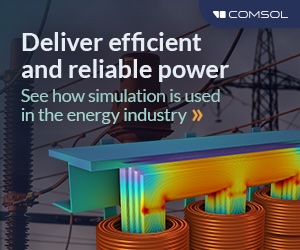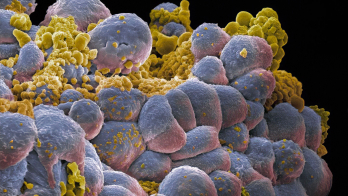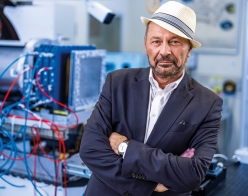
By some counts, there are more than 300 distinct branches of science, a number that continues to grow. In physics alone, which began with astronomy five millennia ago, there are now at least two dozen subdivisions in most taxonomies. Over the past three decades, the science of beams has evolved into a distinct discipline with its own subjects and methods, dedicated peer-reviewed journals – like Physical Review Accelerators and Beams, which turned 25 last year – and nearly two dozen regular regional and international conferences and workshops.
Today, around 5000 accelerator scientists and engineers work in more than 50 countries, collaborating with a pool of technical experts three to four times that size. While most are deeply involved in operations and upgrades, their careers also include designing and constructing new facilities, beam-physics research, developing critical technical components, and project leadership. Their work often involves technology transfer, industrial applications, education and training of future experts, and public and academic outreach.
A global field
The need for regular meetings of the entire field has long been recognised. Historically, regional conferences like the biannual particle-accelerator conferences (PACs) in the US (1965–2009), the biannual EPACs in Europe (1988–2008) and the triannual APACs in Asia (1998–2007) served this purpose. These gatherings covered all types of accelerators, particles and use-cases. As the field became truly global, leaders established the series of international PACs (IPACs), which rotate through the regions in a three-year cycle, convening about 1500 attendees. The 15th IPAC took place from 19 to 24 May in Nashville, Tennessee, with almost 200 registrants from Asia, more than 400 from Europe and nearly 700 from the US.
The “beef” of the conference was in the reports from facilities, but no one person can summarise all the progress, and I must restrict myself to personal highlights in fields that are close to my heart. Fascinating progress was reported on energy-recovery linacs (ERLs) and associated technologies such as superconducting RF and fixed-field-alternating-gradient accelerators, following the recent success of the CBETA accelerator test facility at Cornell. Another hot topic in my eyes was design work and experimental studies towards strong hadron cooling for the Electron–Ion Collider. This year’s progress in industrial and medical accelerators is also impressive, with noteworthy presentations on radioisotope production and radiotherapy (Oliver Kester, TRIUMF and Michael Galonska, GSI), light sources for semiconductor manufacturing (Bruce Dunham, SLAC), accelerator-driven fusion (Richard Magee, TAE Technologies), and 96 exhibitions from companies and institutions worldwide.
CERN’s FCC-ee project was discussed in several sessions. Nuria Catalan-Lasheras (CERN) gave a memorable talk demonstrating impressive progress on high-power klystrons (RF sources). At present, klystrons have about 55% efficiency – RF power divided by wall-plug power – but she noted that they have the potential to go to as high as about 85% efficiency. The path is clear: increase voltage and decrease current, thereby reducing the “microperveance” of the klystrons. This will be crucial at FCC-ee, which must continuously replenish 100 MW of synchrotron radiation losses with 100 MW of RF power. The klystron efficiency improvement alone can save more than 60 MW – fully a third of the current power consumption of the CERN accelerator complex.
The “beef” of the conference was in the reports from facilities, but no one person can summarise all the progress
Muon colliders were presented as a unique opportunity to achieve a substantial energy increase compared to hadrons (Diktys Stratakis, Fermilab). Due to the point-like nature of the muon, the full centre-of-mass energy is available for probing new physics processes in every collision. Therefore, a 10 TeV muon collider can provide comparable high-energy-physics breakthroughs to a 100 TeV proton–proton collider, where colliding partons only carry a fraction of the proton’s energy. Due to its compactness, the cost of a 10 TeV muon collider compares to that of the FCC-ee and is likely to be many times lower than any other alternative concept that can achieve 10 pCM (parton centre-of-mass) energies (T Roser et al. 2023 JINST 18 P05018). The challenge lies in developing technologies for muon production, cooling and acceleration in the next two decades. In the upcoming 19 to 25 years it should be technically feasible for the accelerator community to demonstrate the technologies of a) high-intensity and short proton bunches; b) high-power proton targets; c) muon cooling; d) fast muon acceleration; e) 10 to 12 T superconducting magnets lined with tungsten inserts to protect coils from the muon decay products, and; f) effective spreading of the narrow cones of ultra-high-energy neutrinos by wiggling the beams, to avoid damage caused by the chargeless neutrinos when the muons decay.
In the conference’s closing talk, I reviewed three dozen future-collider proposals, analysed the ultimate energies potentially attainable in all types of colliding beams and accelerators within reasonable cost and power consumption limits, and laid out arguments that energies beyond a PeV (thousands of TeV) can be achieved, concluding that muons are the particles of the future for high-energy physics.
I can attest to IPAC’s success in fostering real-life interactions in the global accelerator landscape
The prize session was a highlight, with acceptance speeches from KEK’s Kaoru Yokoya (APS Wilson Prize) and SLAC’s Gennady Stupakov (IEEE NPSS PAST Award). Yokoya outlined his participation in various electron–positron machines and proposals such as the TRISTAN e+e– collider and the ILC. Stupakov emphasised the importance of beam-dynamics theory in the age of computer modelling and simulations.
Ever since the first edition in Kyoto in 2010, I can attest to IPAC’s success in fostering real-life interactions in the global accelerator landscape. After the conference, I counted more than a hundred encounters of 5 minutes or more – something that would be difficult to achieve at a smaller or more specialised conference. It was pleasing to see many Chinese colleagues attend this US-based conference, but I did not identify any participants from Russia – a concerning development for our science’s international spirit. I hope political barriers will not interfere with next year’s IPAC’25 in Taiwan.
On a personal note, I would like to thank the organisers for putting together great scientific and social programmes, and the dedicated Joint Accelerator Conferences Website team, whose tireless efforts ensured that virtually all conference proceedings – papers, talks and posters – were available online by the final day, setting a standard that other fields of high-energy physics could greatly benefit from.








